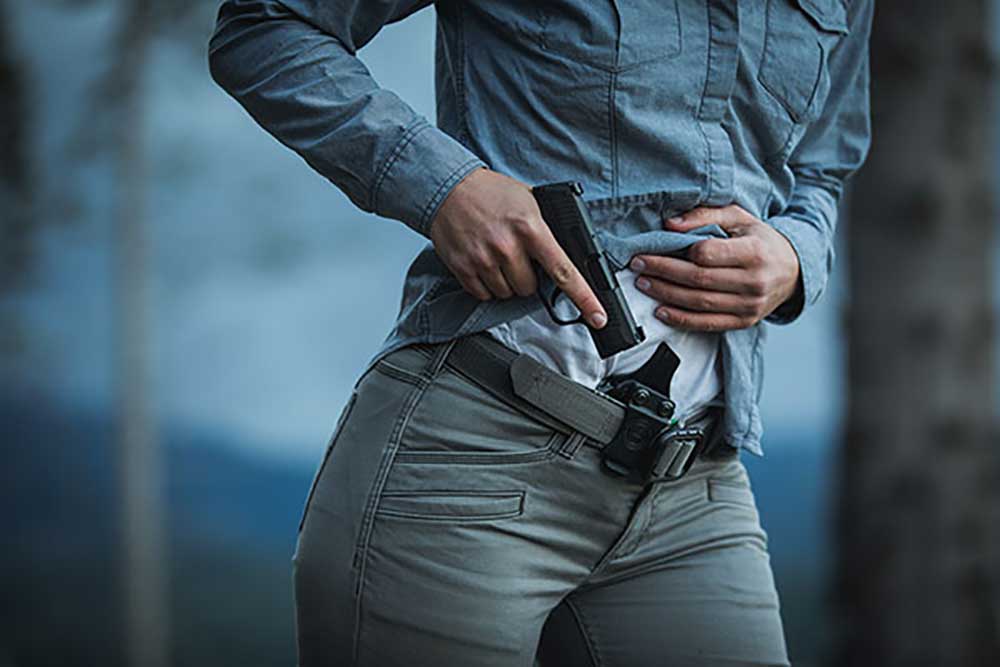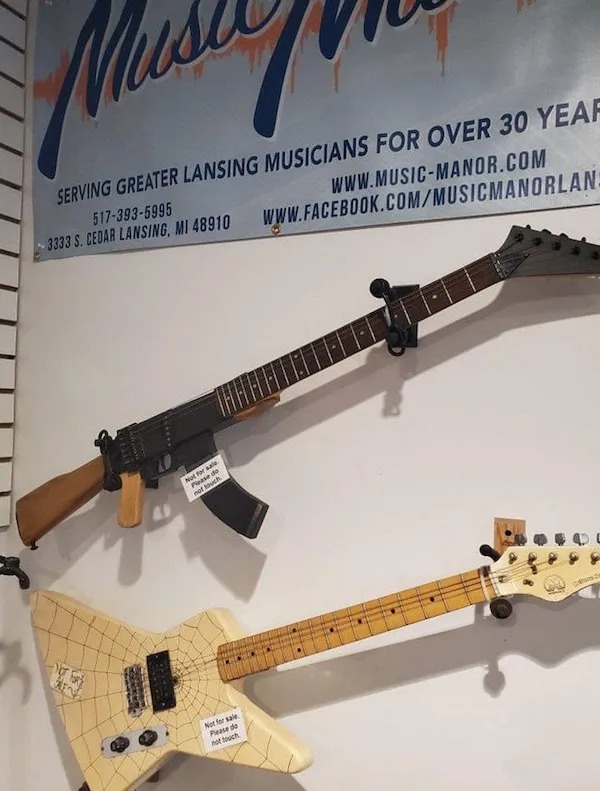‘Merica!
Trumped
- President Donald Trump last week signed the Executive Order Guaranteeing Free and Fair Banking for All Americans, which ends legal banking discrimination against individuals and entities based on political beliefs, such as “guns are bad.”
- Trump nominated two Mississippi Supreme Court justices to federal bench.
Litigation
- California direct-to-home ammo sales without background checks now on hold after state asks for an en banc court rehearing.
- We note that New York also requires a background check for every ammunition purchase. The process is run by the state police, who also mandate that retailers maintain a permanent database recording the buyer’s personal details – everything from their Social Security Number to their occupation – along with the exact caliber, grain, lot number, and quantity of ammunition purchased. There’s a $2.50 fee for every ammo background check and a $9 fee for firearm purchases, including antiques.
- Last week we reported that a Minnesota Appeals Court panel – on Monday – upheld the state’s ban on possessing unserialized firearms. But two days later – Wednesday – in another case, the Minnesota Supreme Court ruled that homemade guns do not fall under the state’s serial number requirement.
- The US Sixth Circuit Court of Appeals held that machine guns are/are not protected by the Second Amendment but are dangerous weapons that aren’t commonly “possessed by law-abiding citizens for lawful purposes,” and a law that criminalizes their possession is therefore consistent with the tradition of firearm regulation in the country, and is therefore constitutional. Yeah, well it’s pretty hard for anything that the federal government has essentially (and unconstitutionally) taxed to death for 50 years and then (unconstitutionally) banned for 40 more years to be legally commonly possessed. It’s a Catch-22. So you ban it, then claim it’s not in common legal use and therefore not protected. That alone queers the court’s decision and reveals the true nature of the judges. As a bonus, one commenter noted that panel ignored the fact that both the NFA and Heller fall outside the historical framework set in the Bruen decision.

- The Second Amendment Foundation and its partners have filed a new lawsuit in Massachusetts challenging the commonwealth’s onerous process for non-residents to acquire a license to carry.
- A three-judge panel on the US Ninth Circuit Court of Appeals has revived a lawsuit filed by three men who were arrested and convicted for carrying without a CCW permit in Los Angeles, at a time when the city was denying virtually everyone who bothered to apply unless they were cops or judges.
- Why 18-Year-Olds Still Can’t Buy Handguns in the Fifth Circuit.
- Another NFA short-barrel case from the Eleventh Circuit. Reprinted here because the original item is behind a paywall:
David Robinson Jr. was convicted of possession of an unregistered short-barreled rifle, and though he could have faced years behind bars, a U.S. District Court judge instead gave him 18 months probation, including 6 months on home detention after concluding they were “not sure society would benefit from putting this young man in jail for any period of time” and they didn’t “think a prison term would satisfy any legitimate societal goal.” Robinson, though, doesn’t believe what he did constitutes a crime at all, and appealed his conviction to the Eleventh Circuit. The appellate court upheld the conviction, opining that the Supreme Court’s decision in Miller back in the 1930s remains binding law. The panel further declared that not only are the NFA’s registration requirements for short-barreled shotguns constitutionally kosher, but that the same registration requirements for short-barreled rifles also pass muster under the Second Amendment. Robinson and his public defender have appealed that decision to the U.S. Supreme Court, and now they’re getting a helping hand from the Second Amendment Foundation, Second Amendment Law Center, California Rifle & Pistol Association, and the Minnesota Gun Owners Caucus. The coalition has filed an amicus brief with the Supreme Court urging them to take up Robinson’s appeal and pointing out several fundamental errors in the Eleventh Circuit’s decision. The most egregious flaw, according to the brief, is that the appellate court didn’t conduct the historical analysis required to determine if gun control laws fit within the text of the Second Amendment and the national tradition of gun ownership. Instead, it simply relied on Miller, but as the coalition notes, the panel ignored the inherent conflict between holding that Miller is the standard, while also claiming that “weapons of war” are unprotected, given that in Miller, SCOTUS concluded that only those weapons useful to a militia are protected by the text of the Second Amendment. That echoes the argument raised by Robinson’s attorney, federal public defender A. Fitzgerald Hall, who says that the appellate court’s reliance on Miller was “misplaced.” “First, Miller did not hold that short-barreled shotguns were not protected arms. Rather, because the defendants “made no appearance in the case, neither filing a brief nor appearing at oral argument,” the Miller Court was not presented ”any evidence tending to show” that short-barreled shotguns were protected and declined to take judicial notice that they were. Consequently, the Miller Court explained, ”we cannot say that the Second Amendment guarantees the right to keep and bear such an instrument.” Declining to hold, ”[i]n the absence of any evidence,” that short-barreled shotguns were protected differs from determining that the Second Amendment does not guarantee a right to possess them. Second, because the Miller Court declined to conclude that short-barreled shotguns were protected arms, Miller stands only for the proposition that the NFA’s restrictions are valid as applied to arms that are unprotected by the Second Amendment. But this says nothing about arms that are protected —such as SBRs today. Moreover, Miller’s holding and focus on whether short-barreled shotguns were protected suggests that the NFA’s restrictions would be unconstitutional as applied to protected arms. If the NFA’s restrictions were constitutional whether or not short barreled shotguns were protected, it would have been senseless for the Court to spend so much of its opinion determining whether they were. Third, even if Miller is read as holding that short barreled shotguns were unprotected arms in 1939, it cannot foreclose a challenge to restrictions on such arms nearly 90 years later because, as Heller explained, ”Miller said . . . that the sorts of weapons protected were those ‘in common use at the time.”’ And Bruen clarifies that over time, unprotected arms can become common — and thus protected — arms: Whatever the likelihood that handguns were considered “dangerous and unusual” during the colonial period, they are indisputably in ”common use” for self-defense today. . . . Thus, even if these colonial laws prohibited the carrying of handguns because they were considered ”dangerous and unusual weapons” in the1690s, they provide no justification for laws restricting the public carry of weapons that are unquestionably in common use today. The 1939 Miller case says nothing about whether SBRs are in common use today. Fourth, even though Miller did not involve SBRs, the court below determined that Miller precludes Robinson’s challenge because he did ”not establish how the distinctions between [SBRs] and short-barreled shotguns present a relevant and material difference that would make one regulation constitutional and the other not.” But that does not justify holding that Miller precludes a challenge to the NFA’s restrictions on SBRs. Dangerousness alone does not remove an arm from Second Amendment protection. ”If Heller tells us anything, it is that firearms cannot be categorically prohibited just because they are dangerous.” Rather, this Court has clarified that a weapon loses Second Amendment protection only if it is both dangerous and unusual, and SBRs are not ”unusual.” In any event, SBRs are not ”dangerous,” either, because they do not differ in function or lethality from other common rifles or handguns. SBRs offer greater stability and accuracy than handguns, making them safer to operate. And they offer greater maneuverability and portability than standard rifles, which are desirable traits for lawful defense.” In their amicus brief, the coalition of 2A groups makes the point that, even if Miller is still considered the standard in determining what arms are protected by the Second Amendment, short-barreled rifles would fit the bill. The M4 carbine is the most common service rifle used by the U.S. military, and it has a barrel length of 14 inches… It’s worth noting that the DOJ waived its right to file a response to Robinson’s petition, and so far no justice has requested to hear from the Solicitor General. That’s not a great sign, but there’s still plenty of time for one more justice to make that request before the Court considers granting cert at its September 29 conference.
Enemies
- New York Attorney Letitia James is facing scrutiny from the Department of Justice, according to a new report by the New York Times. The paper claims that the US Attorney’s Office in Albany, New York has issued several subpoenas against the attorney general related to two of her previous investigations and civil cases; one against Donald Trump and the Trump Organization, and the other against the National Rifle Association.
- Target. Appropriately named.
DGUs

- A reminder from Dr. John Lott.
- More.
- The Armed Citizen:
- West Virginia Homeowner Shoots and Kills Armed Intruder Wielding Bat and Knife
Half a DGU.
- Gun In Vehicle Close Enough To Save Only Half Of Virginia Couple In Home Invasion
- Country Music Star Cancels Shows After Mother Killed in ‘Highly Unusual’ Home Invasion
Jesus Loves You.
Not a DGU.
Tactics & Stuff
- Stampede: What to Know.
- Project: Get Starlink on Your Phone Without A Starlink Account.
- Will It Hurt Me In Court? Weapons Issues and the Fears of the Legally Armed Citizen. Why you might want a lever gun instead of an evil black rifle.
- The Rimfire Report: CCI .22 Shot Shell In Clear Ballistics Gel (3″ penetration).
- Why the US military refuses to adopt bullpup rifles.
Industry News
- Monthly gun-sales-related NICS background checks slid more than 8% year-over-year in July, landing slightly below a million for the first time in almost six years, according to the latest analysis from the NSSF. And there are stupid-good deals to be had.
Air Sig.
- An airman has been arrested in connection with the on-duty shooting death of another airman last month at F.E. Warren Air Force Base in Wyoming, which prompted the Air Force Global Strike Command and others to suspend the use of Sig M18 pistols. The arrest was on suspicion of making a false official statement, obstruction of justice, and involuntary manslaughter. That is all we know. Speculation is that there was horseplay involved and someone actually pulled the trigger, violating Rules 1, 2 and 3. So perhaps that Sig didn’t go bang all by itself. The investigation is ongoing and this is a developing story.
- Well doesn’t everyone use missiles on their crop dusters?
Products

- The new CZ 600+ modular bolt-action rifle series is engineered for precision, versatility, and reliability, with interchangeable barrels and sub-0.75 moa accuracy. Three action lengths, lots of premium features. Very nice.
*************************


